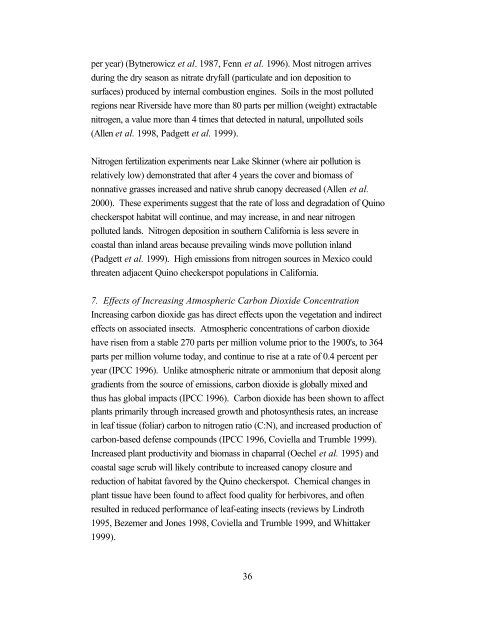Outline of Quino Recovery Plan - The Xerces Society
Outline of Quino Recovery Plan - The Xerces Society
Outline of Quino Recovery Plan - The Xerces Society
Create successful ePaper yourself
Turn your PDF publications into a flip-book with our unique Google optimized e-Paper software.
per year) (Bytnerowicz et al. 1987, Fenn et al. 1996). Most nitrogen arrives<br />
during the dry season as nitrate dryfall (particulate and ion deposition to<br />
surfaces) produced by internal combustion engines. Soils in the most polluted<br />
regions near Riverside have more than 80 parts per million (weight) extractable<br />
nitrogen, a value more than 4 times that detected in natural, unpolluted soils<br />
(Allen et al. 1998, Padgett et al. 1999).<br />
Nitrogen fertilization experiments near Lake Skinner (where air pollution is<br />
relatively low) demonstrated that after 4 years the cover and biomass <strong>of</strong><br />
nonnative grasses increased and native shrub canopy decreased (Allen et al.<br />
2000). <strong>The</strong>se experiments suggest that the rate <strong>of</strong> loss and degradation <strong>of</strong> <strong>Quino</strong><br />
checkerspot habitat will continue, and may increase, in and near nitrogen<br />
polluted lands. Nitrogen deposition in southern California is less severe in<br />
coastal than inland areas because prevailing winds move pollution inland<br />
(Padgett et al. 1999). High emissions from nitrogen sources in Mexico could<br />
threaten adjacent <strong>Quino</strong> checkerspot populations in California.<br />
7. Effects <strong>of</strong> Increasing Atmospheric Carbon Dioxide Concentration<br />
Increasing carbon dioxide gas has direct effects upon the vegetation and indirect<br />
effects on associated insects. Atmospheric concentrations <strong>of</strong> carbon dioxide<br />
have risen from a stable 270 parts per million volume prior to the 1900's, to 364<br />
parts per million volume today, and continue to rise at a rate <strong>of</strong> 0.4 percent per<br />
year (IPCC 1996). Unlike atmospheric nitrate or ammonium that deposit along<br />
gradients from the source <strong>of</strong> emissions, carbon dioxide is globally mixed and<br />
thus has global impacts (IPCC 1996). Carbon dioxide has been shown to affect<br />
plants primarily through increased growth and photosynthesis rates, an increase<br />
in leaf tissue (foliar) carbon to nitrogen ratio (C:N), and increased production <strong>of</strong><br />
carbon-based defense compounds (IPCC 1996, Coviella and Trumble 1999).<br />
Increased plant productivity and biomass in chaparral (Oechel et al. 1995) and<br />
coastal sage scrub will likely contribute to increased canopy closure and<br />
reduction <strong>of</strong> habitat favored by the <strong>Quino</strong> checkerspot. Chemical changes in<br />
plant tissue have been found to affect food quality for herbivores, and <strong>of</strong>ten<br />
resulted in reduced performance <strong>of</strong> leaf-eating insects (reviews by Lindroth<br />
1995, Bezemer and Jones 1998, Coviella and Trumble 1999, and Whittaker<br />
1999).<br />
36
















